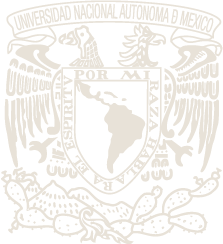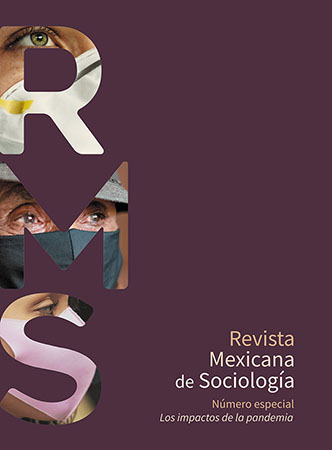The Covid-19 pandemic: Meanings and consequences in the ways of life in Tlahuapan, Puebla
Main Article Content
Abstract
This article aims to discern and interpret the transformations in the way of life
of rural dwellers caused by the Covid-19 pandemic. Drawing on a collaborative semi-virtual ethnography and a household survey conducted in late 2020 in Tlahuapan, Puebla, we examine their experiences, socially constructed meanings, and perceived risks, as well as the material and historical conditions that shape their response to the crisis. Based on this methodology, it is argued that the pandemic has been locally re-signified and expressed in particular ways, affecting our understanding of its consequences and meanings.
Downloads
Article Details

This work is licensed under a Creative Commons Attribution-NonCommercial-NoDerivatives 4.0 International License.

Revista Mexicana de Sociología por Universidad Nacional Autónoma de México se distribuye bajo una Licencia Creative Commons Atribución-NoComercial-SinDerivar 4.0 Internacional. Basada en una obra en http://revistamexicanadesociologia.unam.mx/index.php/rms/.
References
Amit, Vered (2000). “Introduction. Constructing the field”. En Constructing the Field. Ethnographic Fieldwork in the Contemporary Work, coordinado por Vered Amit, 1-18. Londres/Nueva York: Routledge.
Bryant, Raymond, y Sinéad Bailey (1997). Third World Political Ecology. Nueva York: Routledge.
Bryceson, Deborah, Cristóbal Kay y Jos Mooij (coords.) (2007). Disappearing Peasantries? Rural Labour in Africa, Asia and Latin America. The Netherlands: itdg Publishing.
Carton de Grammont, Hubert, y Luis Martínez (comps.) (2009). La pluriactividad en el campo latinoamericano. Quito: Facultad Latinoamericana de Ciencias Sociales.
Clifford, James, y George Marcus (coords.) (1986). Writing Culture. The Poetics and Politics of Ethnography. California: University of California Press.
Comisión Económica para América Latina y el Caribe (CEPAL) (2020). Informe especial Covid-19. América Latina y el Caribe ante la pandemia del Covid-19. Efectos económicos y sociales [en línea]. Disponible en <https://www.cepal.org/es/publicaciones/45337-america-latina-caribe-la-pandemia-covid-19-efectos-economicos-sociales> [consulta: 20 de febrero de 2021].
Consejo Nacional de Población (Conapo) (2015). Índice de marginación [en línea]. Disponible en <http://www.conapo.gob.mx/es/CONAPO/Datos_Abiertos_del_Indice_de_Marginacion> [consulta: 18 de febrero de 2021].
Douglas, Mary, y Aaron Wildavsky (1983). Risk and Culture: An Essay on the Selection of Technological and Environmental Dangers. California: University of California Press.
Ellis-McMillan, Michael C., y Kristin Hedges (2020). “Pandemic perspectives: Responding to Covid-19”. Open Anthropology 8 (1). Disponible en <https://www.americananthro.org/StayInformed/OAArticleDetail.aspx?ItemNumber=25631> [consulta: 16 de febrero de 2021].
Encuesta Nacional de Salud y Nutrición (Ensanut) (2018). Disponible en <https://ensanut.insp.mx/encuestas/ensanut2018/doctos/informes/ensanut_2018_presentacion_resultados.pdf> [consulta: 22 de febrero de 2021].
Flores, Gonzalo, y Octavio Rosas (2009). “Coca-Cola FEMSA, contra México y América Latina”. En Embotellados: el turbio negocio del agua embotellada y la lucha por la defensa del agua, coordinado por Tony Clarke, 231-274. México: Ítaca/Instituto Polaris/Centro de Análisis Social, Información y Formación Popular/Unión de Científicos Comprometidos con la Sociedad.
Fuentes, Agustín (2020). “A (bio)anthropological view of the Covid-19 era midstream: Beyond the infection”. Anthropology Now 12 (1): 24-32.
García Cook, Ángel (1973). “El desarrollo cultural prehispánico en el norte del área, intento de una secuencia cultural”. Comunicaciones. Proyecto Puebla-Tlaxcala 7: 67-71.
Giddens, Anthony (1996). “Modernidad y autoidentidad”. En Las consecuencias perversas de la modernidad: modernidad, contingencia y riesgo, compilado por Josetxo Beriain, 33-71. Barcelona: Anthropos.
Gobierno de México (2021). Disponible en <https://datos.covid-19.conacyt.mx/fHDMap/mun.php> [consulta: 25 de febrero de 2021].
Günel, Gökçe, Saiba Varma y Chika Watanabe (2020). “A manifesto for patchwork ethnography” [en línea]. Fieldsights. Disponible en <https://culanth.org/fieldsights/a-manifesto-for-patchwork-ethnography> [consulta: 25 de febrero de 2021].
Gupta, Akhil, y James Ferguson (1997). “Discipline and practice: ‘The Field’ as site, method, and location in anthropology”. En Anthropological Locations. Boundaries and Grounds of a Field Science, coordinado por Akhil Gupta y James Ferguson, 1-46. Berkeley: University of California Press.
Harvey, David (2005). The New Imperialism. Nueva York: Oxford University Press.
Harvey, David (2020). Razones para ser anticapitalista. Buenos Aires: Consejo Latinoamericano de Ciencias Sociales.
Hine, Christine (2004). Etnografía virtual. Barcelona: Universitat Oberta de Catalunya.
Instituto Nacional de Estadística y Geografía (INEGI) (s/f). México en cifras [en línea]. Disponible en
indicadores> [consulta: 18 de febrero de 2020].
Instituto Nacional de Estadística y Geografía (INEGI) (2000). Censo de Población y Vivienda 2010 [en línea]. Disponible en <https://www.inegi.org.mx/programas/ccpv/2010/> [consulta: 17 de febrero de 2021].
Instituto Nacional de Estadística y Geografía (INEGI) (2009). Prontuario de información geográfica municipal de los Estados Unidos Mexicanos 2009 [en línea]. Disponible en <https://www.inegi.org.mx/contenidos/app/mexicocifras/datos_geograficos/21/21180.pdf> [consulta: 22 de febrero de 2021].
Instituto Nacional de Estadística y Geografía (INEGI) (2015). Encuesta Intercensal 2015 [en línea]. Disponible en <https://www.inegi.org.mx/programas/intercensal/
/> [consulta: 22 de febrero de 2021].
Instituto Nacional de Estadística y Geografía (INEGI) (2021). Censo de Población y Vivienda 2020 [en línea]. Disponible en <https://www.inegi.org.mx/sistemas/Olap/Proyectos/bd/censos/cpv2020/pt.asp> [consulta: 11 de febrero de 2021].
Kearney, Michael (1996). Reconceptualizing the Peasantry: Anthropology in Global Perspective. Boulder: Westview Press.
Kirksey, Eben (2020). “The emergence of Covid-19: A multispecies story”. Anthropology Now 12 (1): 11-16.
Kozinets, Robert (2010). Netnography. Doing Ethnographic Research Online. Londres: Sage.
Marcus, George (1995). “Ethnography in/of the world system: The emergence of multi-sited ethnography”. Annual Review of Anthropology 24: 95-117.
Merino, Leticia, Karla Valverde y Alicia Ziccardi (2020). “Las desigualdades sociales de la Ciudad de México ante la pandemia de Covid-19”. Ciencia. Revista de la Academia Mexicana de Ciencia 71 (3): 38-43.
Millalen, Pablo, Héctor Nahuelpan, Álvaro Hoffinger y Edgar Martínez (2020). “Covid-19 and indigenous peoples in Chile: Vulnerability to contagion and mortality”. AlterNative 16 (4): 399-402. Disponible en [consulta: 22 de febrero de 2021].
Murakami, Tatsuya, Shigeru Kabata, Julieta López y José Chávez (2017). “Development of an early city on Central Mexico: The Tlalancaleca Archaeology Project”. Antiquity 91 (356): 455-473.
Narotzky, Susana (2004). Antropología económica. Barcelona: Melucina.
Narotzky, Susana, y Niko Besnier (2014). “Crisis, value, and hope: Rethinking the economy”. Current Anthropology 55: S4-S16.
Oxlund, Bjarke (2020). “An anthropology of the handshake”. Anthropology Now 12 (1): 39-44.
Pylypa, Jen (2020). “A week in the life of Covid-19 in Ottawa, Canada”. Anthropology Now 12 (1): 33-38.
Rodríguez-Izquierdo, Emilio, Sol Pérez-Jiménez, Leticia Merino, Marisa Mazari-Hiriart (2020). “Spatial analysis of Covid-19 and inequalities in Mexico City. Insights of the cdp members on the Covid-19 crisis”. United Nations-Department of Economic and Social Affairs Economic Analysis. Disponible en <https://www.un.org/development/desa/dpad/wp-content/uploads/sites/45/Covid-19-Mexico-City.pdf > [consulta: 18 de febrero de 2021].
Rose, Arthur, y Luna Dolezal (2020). “Stigma and the logics of wartime”. Fieldsights. Disponible en <https://culanth.org/fieldsights/stigma-and-the-logics-of-wartime> [consulta: 19 de febrero de 2021].
Schneider, Sergio (2000). “Actividades rurales no agrícolas y transformaciones del espacio rural: perspectivas recientes”. Cuadernos de Desarrollo Rural 44: 11-40.
Secretaría de Desarrollo Social (Sedesol) (s/f). Programa para el Desarrollo de Zonas Prioritarias [en línea]. Disponible en <http://www.microrregiones.gob.mx/zaP/> [consulta: 15 de febrero de 2017].
Smith, Will, y Noah Theriault (2020). “Seeing indigenous land struggles in the ‘Multispecies Cloud’ of Covid-19”. Fieldsights. Disponible en <https://culanth.org/fieldsights/seeing-indigenous-land-struggles-in-the-multispecies-cloud-of-covid-19> [consulta: 17 de febrero de 2021].
Universidad Nacional Autónoma de México (UNAM) (2021). Disponible en <https://covid19comisionunam.unamglobal.com/> [consulta: 2 de marzo de 2021].
Whiteford, Linda (2020). “A room with a view: Observations from two pandemics”. Anthropology Now 12 (1): 7-10.


